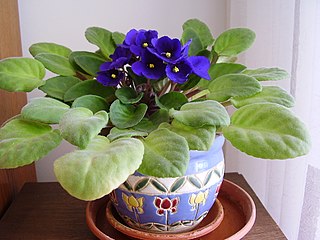
The Marie Selby Botanical Gardens is a 15-acre (6.1 ha) botanical garden located at 900 South Palm Avenue in Sarasota, Florida. The Gardens are located on the grounds of the former home of Marie and William Selby.

Episcia is a genus of flowering plants in the African violet family, Gesneriaceae. The 10 species it contains are native to the tropical regions of Central and South America. They are frequently cultivated elsewhere and sometimes naturalize in tropical regions. The species are perennial herbaceous plants characterized by a stoloniferous habit, red flowers, and frequently have marked or patterned leaves. They are grown in the tropics, and in temperate regions as houseplants, primarily for their attractive foliage. Numerous cultivars have been produced, primarily by selection and hybridization of the species E. cupreata and E. reptans.

Gloxinia is a genus of three species of tropical rhizomatous herbs in the flowering plant family Gesneriaceae. The species are primarily found in the Andes of South America but Gloxinia perennis is also found in Central America and the West Indies, where it has probably escaped from cultivation.

Saintpaulia, commonly known as African violet, is a genus of 6–20 species of herbaceous perennial flowering plants in the family Gesneriaceae, native to Tanzania and adjacent southeastern Kenya in eastern tropical Africa. Typically the African violet is a common household indoor plant but can also be an outdoor plant.

Achimenes is a genus of about 25 species of tropical and subtropical rhizomatous perennial herbs in the flowering plant family Gesneriaceae. They have a multitude of common names such as magic flowers, widow's tears, Cupid's bower, or hot water plant.

Seemannia is a New World genus in the flowering plant family Gesneriaceae. There are four species in the genus, primarily found in the Andean regions of South America. The name honors the German botanist Berthold Carl Seemann.
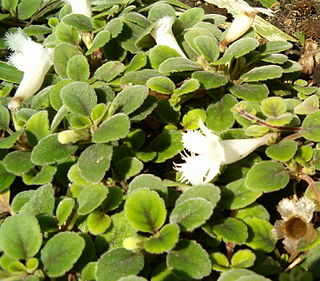
Alsobia is a genus of flowering plants in the family Gesneriaceae, native to Mexico, Guatemala and Costa Rica.
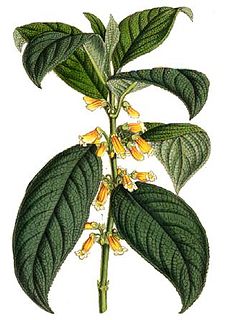
Besleria is a genus of ca. 200 species of large herbs and soft-stemmed subshrubs or shrubs in the flowering plant family Gesneriaceae. They occur in Central America, South America, and the West Indies.
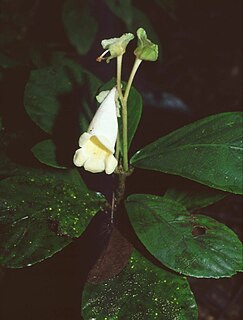
Gasteranthus is a genus of 35 species of herbs and soft-stemmed subshrubs in the flowering plant family Gesneriaceae. The species occur in Central America and South America, from southernmost Mexico to Bolivia. Numerous species are threatened with extinction, mainly due to deforestation. This is due to two reasons: For one thing, Gasteranthus species are native to countries in which destruction of primary forest runs rampant; also, these plants do not distribute well and therefore endemism is very frequent, for example on isolated mountain ranges.
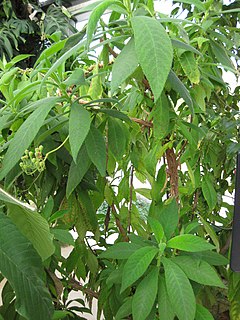
Alloplectus is a genus of Neotropical plants in the flowering plant family Gesneriaceae. A recent revision of the genus includes five species, with the majority of species in the genus as traditionally circumscribed being transferred to Crantzia, Glossoloma, and Drymonia.
Phinaea is a genus of plant in family Gesneriaceae. It contains the following species :

Cyrtandra is a genus of flowering plants containing about 600 species, with more being discovered often, and is thus the largest genus in the family Gesneriaceae. These plants are native to Southeast Asia, Australia, and the Pacific Islands, with the centre of diversity in Southeast Asia and the Malesian region. The genus is common, but many species within it are very rare, localized, endangered endemic plants. The species can be difficult to identify because they are highly polymorphic and because they readily hybridize with each other. The plants may be small herbs, vines, shrubs, epiphytes, or trees. The genus is characterized in part by having two stamens, and most species have white flowers, with a few red-, orange-, yellow- and pink-flowered species known. Almost all species live in rainforest habitats.
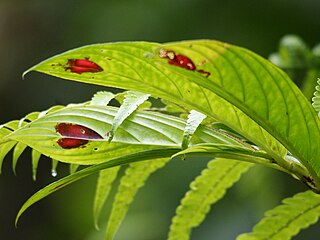
Columnea consanguinea is a species of flowering plants in the genus Columnea. They are endemic to Colombia, Costa Rica, Ecuador, Nicaragua, and Panama. They are distinctive for possessing red translucent heart-shaped markings on their leaves that serve to attract their main pollinators - the hummingbird Heliodoxa jacula - to their more inconspicuous flowers.
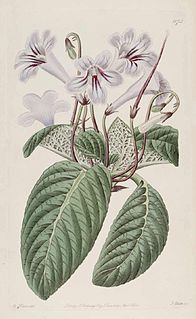
Streptocarpus rexii is a South African plant in the family Gesneriaceae, occurring widely from the southern Cape along the coastal hills, mountains, wooded ravines and valleys, and moist forests of the east coast, through Natal as far north as the Eastern Transvaal, up to an altitude of about 900 m. This genus of epiphytes and lithophytes, of about 130 species, is mainly African and Mascarene, with four vagrant species in Asia. Streptocarpus, as do other Old World Gesneriaceae, is unusual in that it displays anisocotylous or unequal growth, i.e. one cotyledon continues to grow after germination.

Haberlea is a monotypic genus of flowering plants in the family Gesneriaceae. The only member of this genus, Haberlea rhodopensis, is endemic to several mountains in Bulgaria, especially the Rhodope Mountains, and a small part of northern Greece. Common names include Orpheus flower and resurrection plant because of the remarkable ability of Haberlea to survive very long periods of desiccation.
Cyrtandra cleopatrae is a species of plant in the Gesneriaceae family endemic to the Philippines. It is a tropical shrub having recaulescent inflorescences composed of multiple purpled flowers that emerge on the plant stem from stubby shoots. It was first collected for science during a 1998 expedition sponsored by the Royal Botanic Garden Edinburgh, from a location in Palawan called Cleopatra's Needle (elev. 1550m), thus the specific epithet "cleopatrae". The taxon was first published in the Edinburgh Journal of Botany in 2001.
Brickellia argyrolepis is a Mesoamerican species of flowering plants in the daisy family. It is native to Central America and to southern Mexico.
